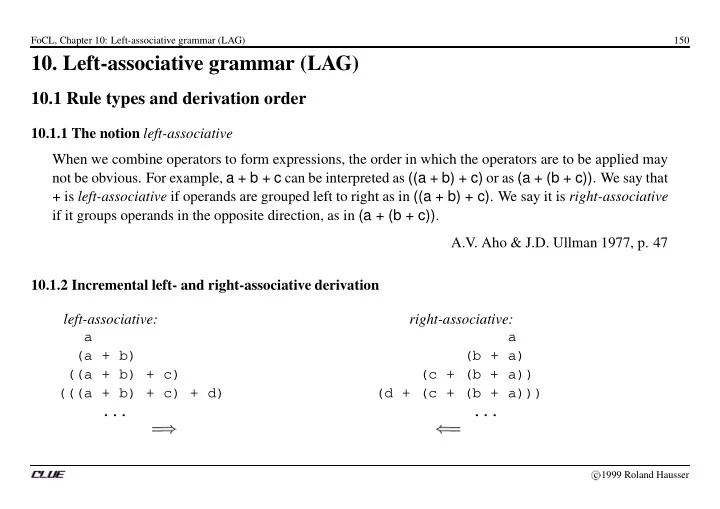

FoCL, Chapter 10: Left-associative grammar (LAG) 150 10. Left-associative grammar (LAG) 10.1 Rule types and derivation order 10.1.1 The notion left-associative When we combine operators to form expressions, the order in which the operators are to be applied may not be obvious. For example, a + b + c can be interpreted as ((a + b) + c) or as (a + (b + c)) . We say that + is left-associative if operands are grouped left to right as in ((a + b) + c) . We say it is right-associative if it groups operands in the opposite direction, as in (a + (b + c)) . A.V. Aho & J.D. Ullman 1977, p. 47 10.1.2 Incremental left- and right-associative derivation left-associative: right-associative: a a (a + b) (b + a) ((a + b) + c) (c + (b + a)) (((a + b) + c) + d) (d + (c + (b + a))) ... ... ) ( = = � 1999 Roland Hausser c
FoCL, Chapter 10: Left-associative grammar (LAG) 151 10.1.3 Left-associative derivation order Derivation is based on the principle of possible continuations Used to model the time-linear structure of language 10.1.4 Irregular bracketing structures corresponding to the trees of C- and PS-grammar (((a + b) + (c +d)) + e) ((a + b) + ((c +d)) + e) (a + ((b + c)) + (d + e)) ((a + (b + c)) + (d + e)) (((a + b) + c) + (d +e)) ... The number of these irregular bracketings grows exponentially with the length of the string and is infinite, if bracketings like (a), ((a)), (((a))), etc., are permitted. 10.1.5 Irregular bracketing structure Derivation is based on the principle of possible substitutions Used to model constituent structure � 1999 Roland Hausser c
FoCL, Chapter 10: Left-associative grammar (LAG) 152 10.1.6 The principle of possible continuations Beginning with the first word of the sentence, the grammar describes the possible continuations for each sentence start by specifying the rules which may perform the next grammatical composition (i.e., add the next word). 10.1.7 Schema of left-associative rule in LA-grammar r i : cat 1 cat ) cat 3 rp 2 i 10.1.8 Schema of a canceling rule in C-grammar � � � ) �� (Y j X) (Y ) (X) 10.1.9 Schema of a rewrite rule in PS-grammar A ! B C � 1999 Roland Hausser c
FoCL, Chapter 10: Left-associative grammar (LAG) 153 10.1.10 Three conceptual derivation orders LA-grammar C-grammar PS-grammar � I @ � @ � @ � @ I � � @ I � @ R � @ � @ � @ � @ � I @ � � @ I � � I @ � � R @ � R @ � @ � @ � @ � @ � I @ � � @ I � R @ � @ � @ bot.-up left-associative bottom-up amalgamating top-down expanding � 1999 Roland Hausser c
FoCL, Chapter 10: Left-associative grammar (LAG) 154 10.2 Formalism of LA-grammar 10.2.1 Algebraic definition of LA-grammar A left-associative grammar (or LA-grammar) is defined as a 7-tuple < W, C, LX, CO, RP, ST S , ST > , where F 1. W is a finite set of word surfaces . 2. C is a finite set of category segments . + ) is a finite set comprising the lexicon . 3. LX � (W � C � + ) into C � 4. CO = (co 0 ... co n � 1 ) is a finite sequence of total recursive functions from (C � C [ { ? }, called categorial operations . 5. RP = (rp 0 ... rp n � 1 ) is an equally long sequence of subsets of n, called rule packages . 6. ST S = {(cat s rp s ), ...} is a finite set of initial states , whereby each rp s is a subset of n called start rule package + . and each cat � C s � and each rp 7. ST F = {( cat f rp f ), ...} is a finite set of final states , whereby each cat � C � RP. f f � 1999 Roland Hausser c
FoCL, Chapter 10: Left-associative grammar (LAG) 155 10.2.2 A concrete LA-grammar is specified by 1. a lexicon LX (cf. 3), 2. a set of initial states ST S (cf. 6), 3. a sequence of rules r i , each defined as an ordered pair (co i , rp i ), and 4. a set of final states ST F . k b k 10.2.3 LA-grammar for a def {[ a (a)], [ b (b)]} LX = ST S = def {[(a) { r 2 }]} 1 , r r 1 : (X) (a) ) (aX) { r 2 } 1 , r r 2 : (aX) (b) ) (X) { r 2 } def {[ " rp ST F = 2 ]}. � 1999 Roland Hausser c
Recommend
More recommend